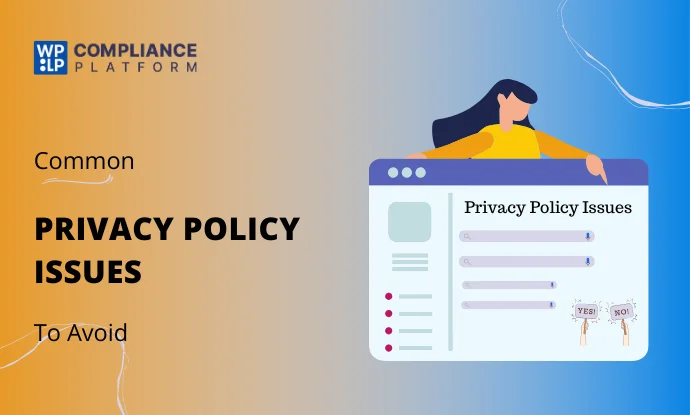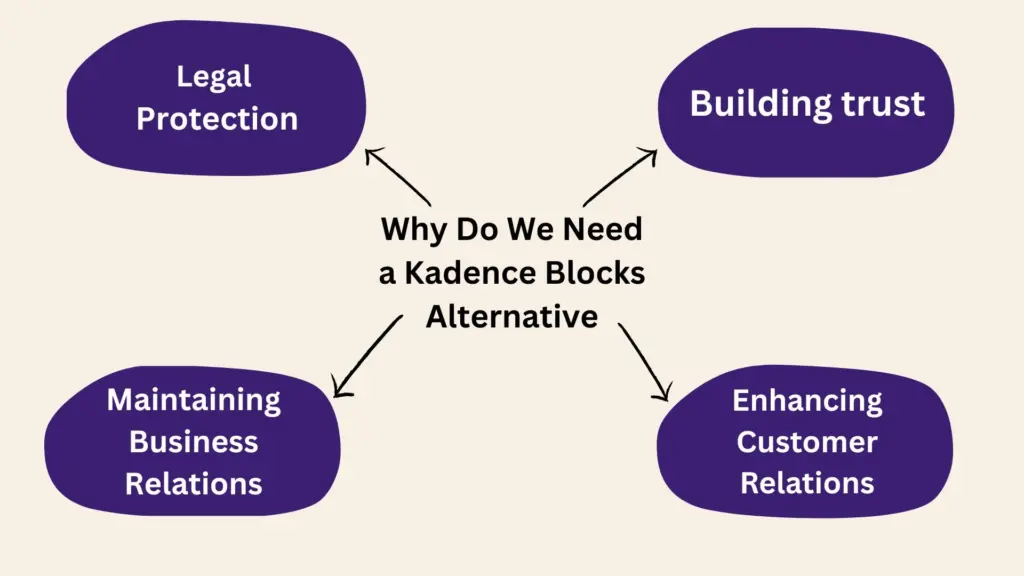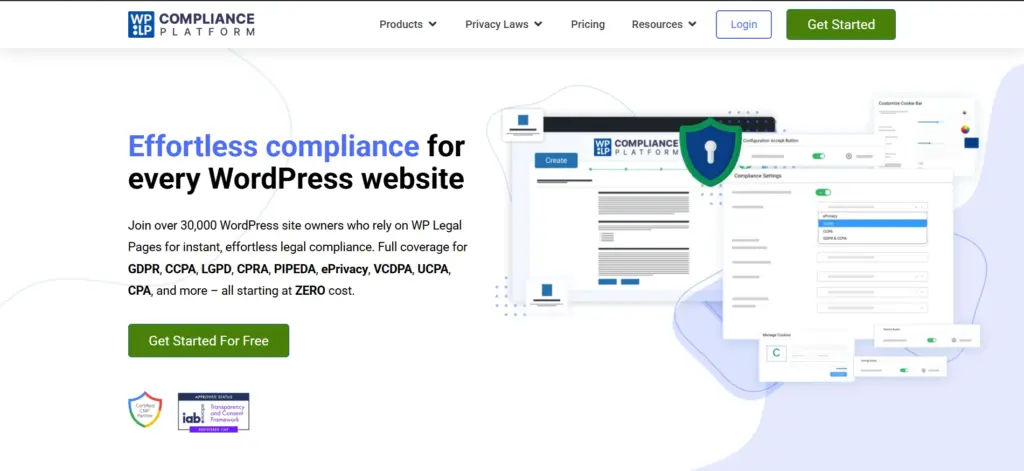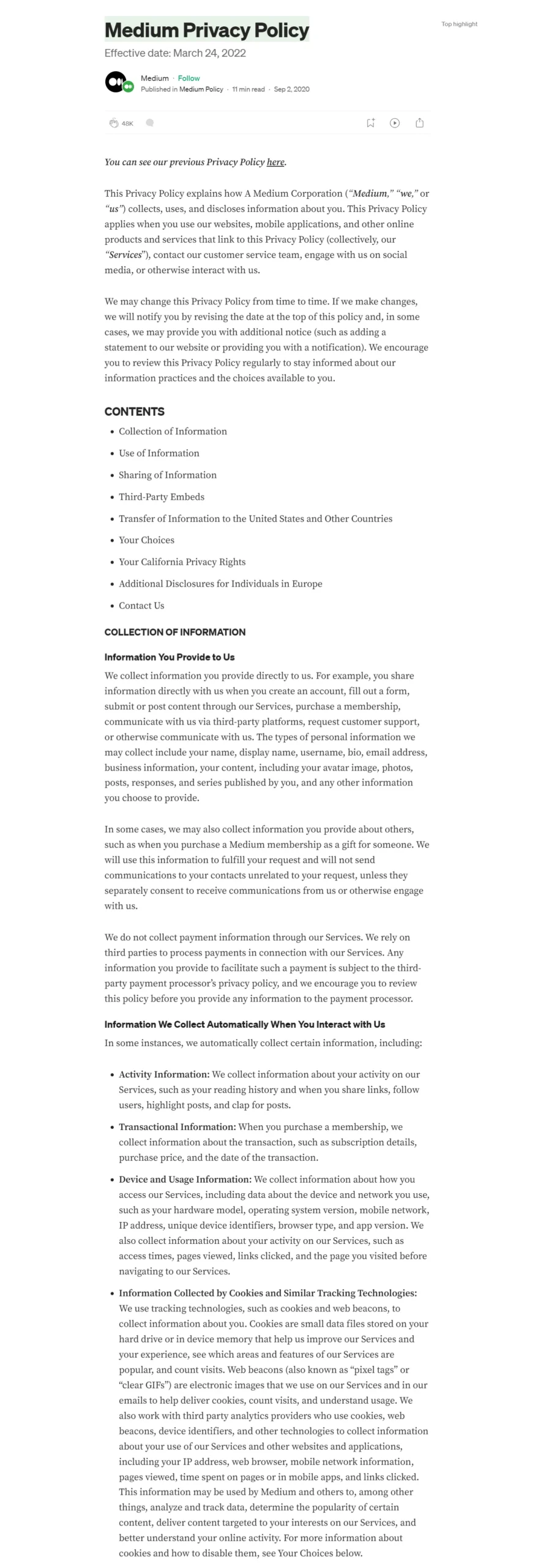11 Privacy Policy Mistakes to Avoid on Your Website in 2025

Summary
By ensuring that your site is transparent in data collection, providing clear consent options, and auditing your policies regularly, you build user trust and protect your business from legal risks and costly fines under laws like GDPR, LGPD, and CCPA.
Make use of the WPLP Compliance platform, which makes generating legal pages, such as a privacy policy, a game-changer by helping you avoid common mistakes.
Are you facing the same privacy policy issues as other website owners?
Your company’s privacy policy must be carefully reviewed and must be free of errors to avoid facing severe consequences.
A privacy policy aims to disclose the types of information a company gathers, how it is obtained, and how a company uses it. To create an effective privacy policy, you must remember a few things.
You must decide what information to include in your privacy policy, ensure it is presented clearly and easily, and update it regularly to reflect changes in data collection and usage practices.
In this article, we will discuss some major privacy policy issues or common privacy policy mistakes people make, along with suggestions for avoiding them.
- What is Website Privacy Policy?
- What Must a Privacy Notice Contain?
- Why a Fully Compliant Privacy Policy is Essential
- Common Privacy Policy Issues to Avoid
- 1. Not Disclosing All the Data Collection Techniques
- 2. Copying a Policy From a Different Website
- 3. Never Reviewing Your Privacy Policy After Writing
- 4. Using Complex Language
- 5. Collecting Optimal Data that Works For Your Website
- 6. Missing Important Clauses
- 7. Not Taking Consent From Users
- 8. Not Providing Accurate Information
- 9. Using AI-Generated Privacy Policy
- 10. Not Updating Your Privacy Policy Regularly
- 11. Hiding Your Contact Information
- Where Does the WPLP Compliance Platform come into the picture?
- Best Privacy Policy Example
- Conclusion
What is Website Privacy Policy?
A website privacy policy is a legal document describing how a company manages user data obtained during business operations. It also covers the user’s rights regarding the data and how it gathers, stores, uses, shares, and secures.
A privacy policy is required by law in the European Union (GDPR Privacy Policy), the State of California (CCPA Privacy Policy), and other jurisdictions. It might be necessary to have a privacy policy to comply with privacy laws.
The website’s privacy policy should specify whether third-party cookies and other data are stored on a user’s device. Additionally, the policy should explain its reason and purpose if the website plans to share or sell user data to third parties.
What Must a Privacy Notice Contain?
The definition of personal data varies depending on various worldwide laws, but it generally refers to any information that can be used to identify an individual.
A privacy policy must contain the following:
- Your full contact details
- The types of personal data you collect
- Where do you get people’s data from, if it wasn’t from them
- Why do you have people’s information, and what are you doing with it
- Your lawful basis and your legitimate interests, where relevant
Certain websites also gather sensitive information, such as bank records, biodata, or information belonging to children. If a company collects such data, it must be disclosed in its privacy policy.
Why a Fully Compliant Privacy Policy is Essential

A privacy policy isn’t just a legal formality; it is a critical tool for your business’s legal protection, customer trust, and operational integrity.
- Legal Protection: Your website’s privacy policy is a binding agreement between your business and its users. Without it, you don’t have the authority to manage user data, safeguard your intellectual property, or limit your liability. In the event of a data breach, regulatory bodies such as the Europe’s General Data Protection Authorities or the California Privacy Protection Agency (CPPA) will review your policy to assess compliance. Non-compliance can put you at significant risks and penalties, potentially reaching up to 4% of a company’s annual global revenue.
- Building Trust: AT a time where data privacy is of utmost concern, a clear and straightforward privacy policy demonstrates your dedication to protecting users. It enhances your credibility and helps differentiate you from competitors. When users feel secure about their data with you, they are more interested in interacting with your website and making purchases.
- Maintaining Business Relationships: Many third-party services and advertising partners require a compliant privacy policy as a prerequisite for collaboration. A strong policy is essential for modern business partnerships, particularly in e-commerce and marketing sectors.
- Enhancing Customer Relationships: A well-crafted privacy policy clarifies how user data is being utilized, outlines their rights, and explains how to exercise those rights. This level of transparency fosters positive relationships and can contribute to a more loyal customer base.
Common Privacy Policy Issues to Avoid
We have compiled a list to help you understand the most common privacy policy issues that website owners and individuals face regarding internet privacy rules.
Here are the top 11 privacy policy Issues to avoid when dealing with privacy notices.
1. Not Disclosing All the Data Collection Techniques
Not disclosing the data collection practices is one of the major privacy policy issues that every website owner faces.
You must ensure you know the personal information you and any third parties are gathering about your users via your app or website.
It’s important to inform your users when collecting data by including it in your privacy policy and using a transparent data collection technique. This will help establish trust with your users.
Remember to update your agreement regularly if your data collection practices change. According to the FTC, many companies can face legal consequences for neglecting to maintain an updated privacy policy. This results in heavy fines.
The fix?
It is important to be explicit and provide a clear list of every type of data you collect and the third-party services you use, how and why you collect them, and where it is stored.
We recommend using the WPLP Compliance Platform, which helps you store all the user consents safely and maintain transparency.
2. Copying a Policy From a Different Website
One of the most common privacy policy mistakes a website owner makes while generating a privacy policy is copying a policy from a different website. A privacy policy is not the same for all websites, so you shouldn’t duplicate a privacy policy because it works for that particular website.
Your privacy policy must align with your company’s operations. Otherwise, it is useless. Copying someone else’s privacy policy could lead to legal issues.
Creating customized privacy policies based on your company’s structure is important for engaging with customers and helping them understand how to use your online platform.
Doing this lets you make the most of your privacy policy and shape it into an honest protection that maintains your online business activities and operations.
3. Never Reviewing Your Privacy Policy After Writing
Another common privacy policy issue you want to avoid is not carefully reviewing your privacy policy before publishing it.
It’s crucial to regularly review your privacy policy to ensure it describes the information you collect and how you use it. For instance, you should update your privacy policy with clear and concise details about data collection procedures whenever you modify your website or add new services that collect user data.
Keeping an up-to-date privacy policy can also help you comply with the law and regulations and earn the trust of your users.
4. Using Complex Language
When crafting the terms of your privacy policy, avoid using unnecessary legalese or terminology. Many business owners make the mistake of using complex words and phrases that lawyers use, which is difficult for the average reader to grasp.
Websites that do not have privacy policies written in simple English violate several laws, including the GDPR. This benchmark ensures transparency by enabling everyone to learn about and understand what happens to their personal data and data rights.
It is recommended to avoid writing long and complex sentences that are tightly packed together. It is better to break them down into shorter, simpler sentences to make them easier to read and understand.
When drafting your privacy policy, consider your intended reader and include techniques like bullet lists, tables, charts, and graphics to make the document easy to navigate.
The Fix?
Make use of plain language, headings, and bullet points to improve readability. Keep the language as simple and easy to understand as possible.
5. Collecting Optimal Data that Works For Your Website
One issue with privacy policies is that website owners sometimes collect more data than they need. It’s important to gather only the information necessary for your website’s operation, not more than you have stated.
For example, if you only need email addresses, that’s all you should collect. You should not try to obtain additional data without permission or accidentally gather more than necessary.
If you want to collect more data from the customer, you should get user consent by using any CMS plugin. We recommend using the WP Cookie consent plugin for explicit user consent. It’s important to be transparent about what information you are collecting and why.
6. Missing Important Clauses
It’s important that you don’t overlook any important clauses that pertain to your company and influence your privacy statement.
Because the internet is so widely used and people of all ages from ant part of the world can access your website.
Make sure to comply with privacy laws like CCPA, COPPA, GDPR, and CALOPPA.
For an easy solution, you can use the WP Legal Pages plugin, a free privacy policy generator, to quickly create legal policies for your website.
Pro tip:
Use the WPLP Compliance Platform to never miss any important sections in your legal pages ever again due to the 35+ legal templates for you to choose from.
7. Not Taking Consent From Users
As per privacy regulations, you’re required to obtain user consent before collecting data. Your privacy policies are effective when users read the most important sections and agree to the terms and guidelines stated.
For this reason, GDPR has a higher consent requirement when dealing with privacy policies. Not gathering consent is a clear violation.
To fix this, you can utilise the WPLP Compliance platform, which gives you the ability to avoid collecting data before the user gives consent.
8. Not Providing Accurate Information
Another important problem you want to avoid with your privacy policy is not providing accurate information. Your policy must be intended to safeguard users’ privacy and guarantee that their personal data is handled securely and responsibly.
Businesses that fail to include crucial information in their privacy policies risk lawsuits, losing customers’ trust and damaging their reputation.
Regularly reviewing and updating privacy policies is crucial to ensuring compliance with changing regulations and informing users of any changes in data handling procedures.
9. Using AI-Generated Privacy Policy
One of the major mistakes people make with privacy policy is generating it with the help of AI. Using AI, specifically ChatGPT, isn’t the most cost-effective or practical way to draft a legally acceptable privacy policy.
AI requires a lot of user input to create a legally binding privacy policy, which might take hours of labor for any person unfamiliar with privacy regulations. Since AI Privacy Policies are not automatically updated, they cannot keep up with changes in data privacy laws.
Also, drafting a privacy policy with AI will have some inaccuracies and a lack of legal knowledge. Instead, you can create a privacy policy for a website using popular plugins like WP Legal Pages.
To fix this, you can install the WPLP Compliance Platform plugin and choose from 35+ legal templates, which can make your legal pages in minutes. The wizard also guides you to customise your legal pages according your needs.
10. Not Updating Your Privacy Policy Regularly
Another problem you must avoid is ignoring to update or modify your privacy policy after putting it on your website.
Your privacy notice must appropriately reflect your current data collecting and processing activities. If not, it will immediately breach data privacy laws and mislead users of your websites.
For instance, companies are required by laws such as the California Consumer Privacy Act (CCPA) to update their privacy policies at least once every 12 months.
To fix this, you must conduct regular audits and update your policies whenever your business or the relevant regulations change.
11. Hiding Your Contact Information
Hiding your contact information in your privacy policy is not recommended, as it may lead to customer dissatisfaction.
It is important to provide your contact details, such as email address, postal address, and phone number, for transparency and to build trust with your customers.
Hiding contact information is not always protected by privacy laws. Many jurisdictions have specific laws governing contact information privacy, but the level of protection can vary.
To fix this, be explicit and provide a clear list of your contact details, so that users can contact you if they want to access information regarding their data, that is, how and why you collect them, and where it is stored.
We recommend using the WPLP Compliance Platform, which helps you store all the user consents safely and maintain transparency.
Where Does the WPLP Compliance Platform come into the picture?

The WPLP Compliance Platform is a popular consent management tool on WordPress that helps you create a professional privacy policy tailored to your requirements across multiple geographies.
When a website has clearly defined policies, users feel reassured and are likely to engage with the site with trust, confidence, and a positive mindset.
Using the WPLP Compliance Platform, you can create pages for professional privacy policies, as well as terms of use, terms & conditions, eCommerce returns & refund policies, affiliate disclaimers & more. You can also create cookie banners in seconds.
Features and Benefits of WPLP Compliance Platform
WPLP Compliance Platform has multiple expert-vetted legal pages and cookie banners. Additionally, bloggers, affiliate marketers, corporate websites, e-commerce stores, and consultants use WP Legal Pages for its ease of functionality and legal compliance.
It offers you over 25 templates to choose from that will cover most of your compliance requirements. Whether you need disclaimers, refund policies, affiliate agreements, or anything else, the pro version has got you covered.
Let’s explore more features:
- Library of Legal Templates: WPLP Compliance Platform offers a wide selection of pre-designed legal templates, including privacy policies, terms and conditions, disclaimer statements, and more.
- Announcement Banner: Display announcement banners on your website whenever any legal pages have been updated.
- Responsive Pop-Ups: WPLP Compliance Platform offers an option to create functional and responsive popups. These pop-ups can showcase forced agreements or privacy policies to the users.
In a nutshell, this plugin is a one-stop destination for all your compliance and privacy requirements without even requiring a lawyer to start out.
Best Privacy Policy Example
If you want to be open and honest with your users about the personal information you gather and how you use it, you must publish a privacy policy agreement on your website. Here’s a privacy policy example of a well-known website:

In this privacy policy sample, the Medium website posted its privacy policy link at its footer. The format and theme of the Privacy Policy agreement are consistent with the rest of the website and don’t have any anchor navigation.
This privacy statement sample has a different section for the European Economic Area (EEA), the United Kingdom, and Switzerland. The privacy policy of the Medium website is very detailed and covers all the necessary clauses that a privacy policy should consist of.
To create an error-free privacy policy page, it is recommended that you go through the above privacy policy issues so you can avoid mistakes.
Conclusion
Now that you know the common privacy policy issues that affect your website privacy notice, you can create a detailed and easy-to-understand privacy policy with data privacy regulations.
Remember these privacy policy issues while drafting your privacy notice to ensure that you don’t make such common privacy policy mistakes. Make sure your website complies with data privacy laws.
We recommend using WP Legal pages, a free Privacy Policy Generator, to create a customized agreement that meets all your privacy compliance requirements.
If you liked reading this article, don’t forget to read our other engaging articles:
- Understanding Privacy Statements and Simplifying Compliance
- How To Add Copyright Text To A Website
- Top Website Legal Requirements and Tips to Meet Them
Are you excited to create a terms and conditions page for your online website? Grab WP Legal Pages now!
